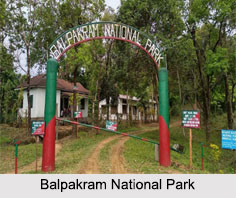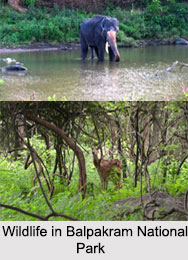 Balpakram National Park is situated in the South Garo Hills district of Meghalaya. It was established in 1987, at an altitude of 3,000 ft above sea level and covers an area of around 220 sq. km. The western part of the park adjoins with Siju Bird Sanctuary along the banks of Simsang River. Very rare forms of wildlife found in this area, has raised a lot of interest in the eco-tourists. The park is home to one of the rarest animals in the world, the Lesser Panda or the Red Panda.
Balpakram National Park is situated in the South Garo Hills district of Meghalaya. It was established in 1987, at an altitude of 3,000 ft above sea level and covers an area of around 220 sq. km. The western part of the park adjoins with Siju Bird Sanctuary along the banks of Simsang River. Very rare forms of wildlife found in this area, has raised a lot of interest in the eco-tourists. The park is home to one of the rarest animals in the world, the Lesser Panda or the Red Panda.
Flora and Fauna at Balpakram National Park
Balpakram National Park is home to wide species of plants and animals. Its vegetation consists of sub-tropical, tropical deciduous trees and pitcher plant. Exotic species of herbs and plants having medicinal value are also found in this national park.
There are many animals inhabiting the national park, including the wild cow, elephant, wild bison, deer, barking deer, wild boar, slow loris, wild water buffalo, red panda, clouded leopard, tiger, marbled cat and the rare golden cat. This park is also known as prime birding site as tourists can spot various species of birds such as great and common hornbill</b>, peacock, oriole, kingfisher, Indian roller etc. The rivers and lakes in the wildlife reserve are home to variety of reptiles like python, king cobra, viper, krait, monitor lizard, gecko, etc.
 Myths about Balpakram National Park
Myths about Balpakram National Park
Balpakram has many mysterious and unnatural phenomena that cannot be satisfactorily explained by modern science and logic. The Garos believe this hill to be the sort of resting place for departed souls. Balpakram means "land of the eternal wind" according to the myth of the Garo people.
There is also a thick Schima Wallichi Tree in the national park, which has a depression on its trunk which seems to be the outcome of constant tethering of animals and the work of harsh weather. Whenever a tree falls due to the strong winds, another tree situated closeby gets affected with the same symptoms.
Visiting Information of Balpakram Park
The ideal time to visit Balpakram National Park is from November to May when the weather is pleasant without rainfall. Mid April to Mid June is the best time to spot birds and wildlife. The best way to reach Balpakram National Park is via Tura. The nearest airport and rail station is Guwahati in Assam which is 220 km from Tura.



















